In recent years, the kitchen appliance industry has witnessed a significant shift towards automation, particularly in the realm of restaurant equipment. Steak machines, a testament to this trend, have emerged as a game-changer in the culinary landscape. This piece delves into the intricacies of steak machine manufacturing, the competitive market landscape, and the myriad benefits they bring to the restaurant industry. We’ll also explore the innovative strides being made and the challenges Original Equipment Manufacturers (OEMs) face in this dynamic sector. As consumer insights and market feedback continue to shape the direction of the industry, we’ll reflect on where steak machines and the broader kitchen appliance market are heading in the future.
The Rise of Automation in European and American Kitchen Appliances
The culinary landscape in Europe and America has undergone a remarkable transformation, with automation taking center stage in the realm of kitchen appliances. This surge in technological integration isn’t merely a passing trend; it’s a strategic shift that’s reshaping the way we perceive and utilize kitchen equipment. From the bustling streets of Paris to the vibrant diners of New York, the integration of automation in kitchen appliances has become a necessity for efficiency, quality, and innovation.
In recent years, the demand for sophisticated kitchen appliances has soared, driven by a combination of factors. The rise of health-conscious consumers, the increasing popularity of fine dining experiences, and the need for streamlined operations in the fast-paced restaurant industry have all contributed to this growth. The result is a market where high-tech appliances are not just a luxury but an essential tool for success.
One of the standout appliances in this automation revolution is the steak machine. These innovative devices have gained traction for their ability to deliver consistent and high-quality steaks, a task that was once the exclusive domain of skilled chefs. The European and American markets, with their discerning palates and demand for excellence, have been at the forefront of adopting this technology.
In Europe, the culinary heritage is steeped in tradition, yet there’s a growing acceptance of modern methods that enhance the cooking process. From Italy’s pasta makers to Germany’s precision ovens, the continent has embraced automation as a way to maintain quality while also scaling operations. The same can be said for the United States, where the fusion of cultural cuisines has opened doors for innovative cooking technologies.
The steak machine, in particular, has become a symbol of this technological advancement. These machines are designed to cater to the precise temperature and timing requirements for cooking steaks, ensuring that each cut is cooked to the perfect doneness. The ease with which these machines can replicate the skills of a seasoned chef has made them a must-have for many restaurants.
The rise of OEM (Original Equipment Manufacturer) partnerships has been instrumental in driving this automation trend. OEMs are playing a crucial role by producing these steak machines and integrating them into a wide range of kitchen settings. This collaboration between manufacturers and restaurant owners has led to a more streamlined and efficient supply chain, allowing for faster deployment of the latest technologies.
Market analysis shows that the demand for steak machines is on the rise, with predictions indicating a steady growth trajectory. The European Union and the United States are the largest markets for these devices, thanks to their robust culinary cultures and the high value placed on food quality. As more restaurants look to differentiate themselves through superior service and product quality, the steak machine has become a key differentiator.
In terms of key players, several OEMs have emerged as leaders in the steak machine market. These companies not only produce high-quality machines but also offer extensive customization options to suit the specific needs of their clients. Their focus on research and development has led to constant improvements in the technology, making these machines more reliable and user-friendly.
The benefits of steak machines in the restaurant industry are multifaceted. They reduce labor costs by minimizing the need for skilled labor in the cooking process. They also increase consistency, as every steak is cooked to the same high standard. Moreover, the precision of these machines allows for the exploration of new recipes and cooking techniques, pushing the boundaries of culinary creativity.
Innovation in steak machine technology is ongoing, with manufacturers constantly seeking to improve their designs. Features such as temperature control, speed settings, and even digital interfaces are becoming standard, making the cooking process more intuitive for chefs. Additionally, the integration of data analytics allows for real-time monitoring and adjustment, ensuring that every steak is cooked to perfection.
Despite the numerous benefits, there are challenges and considerations for OEMs. The cost of these machines can be a barrier for some restaurants, particularly smaller establishments. Additionally, there’s a learning curve associated with using such advanced technology, which may initially affect efficiency. However, these hurdles are being addressed through better training programs and more accessible pricing models.
Consumer insights reveal a strong preference for restaurants that use technology to enhance their offerings. Customers appreciate the consistency and quality that these machines provide, and they’re increasingly willing to pay a premium for these experiences. This trend is likely to continue as technology becomes more integrated into the dining experience.
In conclusion, the rise of automation in European and American kitchen appliances, particularly in the form of steak machines, is a testament to the evolving nature of the culinary industry. As OEM partnerships continue to flourish and technological advancements push the boundaries of what’s possible in the kitchen, it’s clear that automation will play a pivotal role in shaping the future of foodservice.
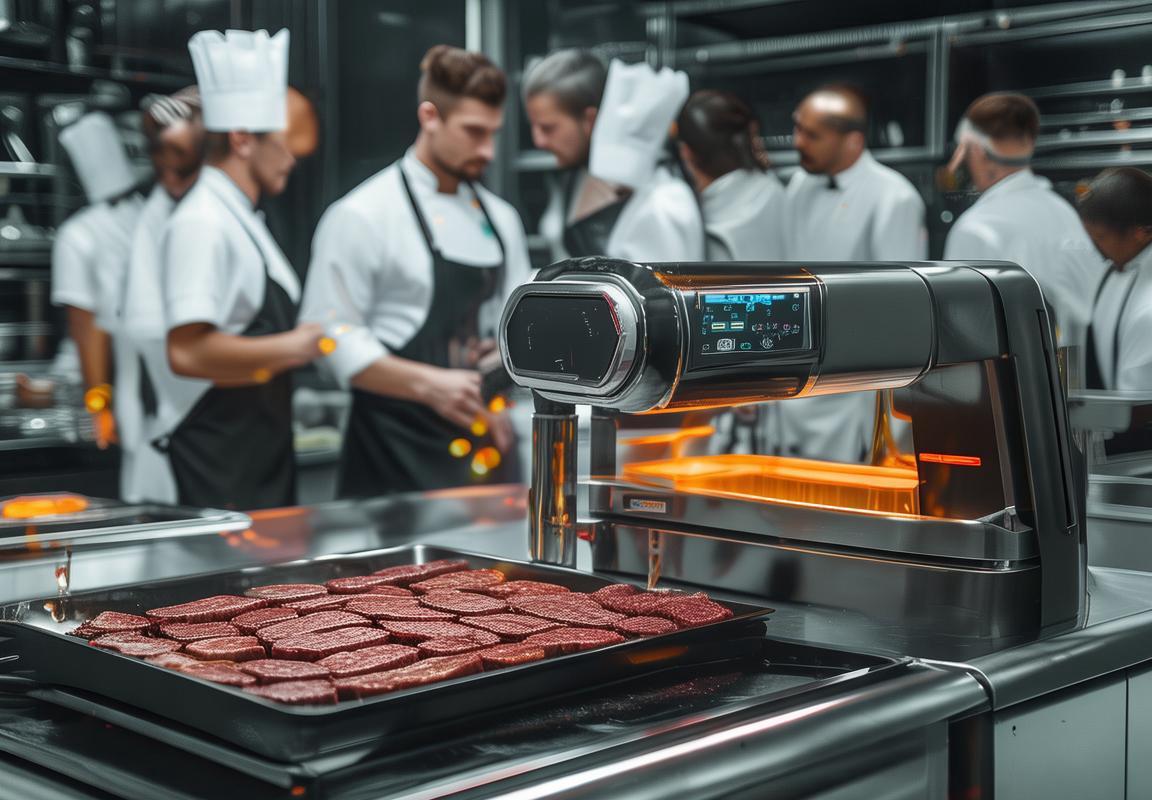
Understanding the Demand for Steak Machines in Restaurant Settings
The demand for steak machines in restaurant settings has seen a significant surge in recent years, reflecting a broader trend towards automation and efficiency in the culinary industry. This demand can be attributed to several key factors that have reshaped the landscape of restaurant operations.
Restaurants are under constant pressure to streamline their processes and enhance the quality of service. With the advent of steak machines, these establishments are finding a solution that not only improves the consistency of their dishes but also frees up staff to focus on customer interaction and other critical tasks. The ability to serve high-quality steaks with minimal human intervention has become a competitive edge in a market where customers expect both speed and excellence.
One of the primary drivers of steak machine demand is the rise of fast-casual dining concepts. These establishments are known for their quick service and affordability, and steak machines fit perfectly into this model. They can churn out perfectly cooked steaks in a matter of minutes, ensuring that the restaurant maintains its fast-paced service without compromising on the quality of the food.
The demand is also being fueled by the growing preference for healthier eating options. Many consumers are looking for leaner cuts of meat that are still flavorful and satisfying. Steak machines offer the precision needed to cook leaner cuts to perfection, meeting the dietary needs of health-conscious customers without sacrificing taste.
Another factor contributing to the popularity of steak machines is the rise of gourmet fast food. Chains and independent restaurants alike are seeking to elevate their offerings by incorporating gourmet elements into their menus. Steak machines can be customized to cook steaks with a variety of seasonings and cooking techniques, allowing these establishments to offer unique and high-end dining experiences at a faster pace than traditional cooking methods.
The convenience factor cannot be overstated. In a world where time is a luxury few can afford, the ability to quickly prepare a high-quality steak is a game-changer. Steak machines reduce the wait time for customers, which is crucial in environments where every minute counts. This efficiency is particularly important in areas with high foot traffic, such as airports, sports stadiums, and shopping centers.
From a cost perspective, steak machines can offer significant savings. While the initial investment may be substantial, the long-term benefits include reduced labor costs and lower food waste. The machines can precisely control the cooking temperature and time, minimizing overcooking and undercooking, which in turn reduces the amount of food that needs to be discarded.
Moreover, the versatility of steak machines is attracting a wide range of restaurants. From upscale steakhouses to casual diners, the ability to serve a wide variety of steak dishes from a single machine is highly appealing. This versatility allows restaurants to adapt to changing menu trends and customer preferences without the need for extensive kitchen renovations.
The technology behind steak machines has also evolved to cater to the demands of modern restaurants. Advanced features such as programmable cooking times, adjustable heat settings, and integrated seasoning systems have made these machines more user-friendly and adaptable to different types of steak preparation. This level of customization ensures that each steak is cooked to the diner’s preference, further enhancing the dining experience.
In conclusion, the demand for steak machines in restaurant settings is a direct response to the evolving needs of the culinary industry. The combination of efficiency, quality, health consciousness, convenience, and cost-effectiveness has made steak machines an indispensable tool for many restaurants looking to stay ahead in an increasingly competitive market. As technology continues to advance, it’s likely that the demand for these innovative appliances will only grow, further solidifying their place in the modern kitchen.
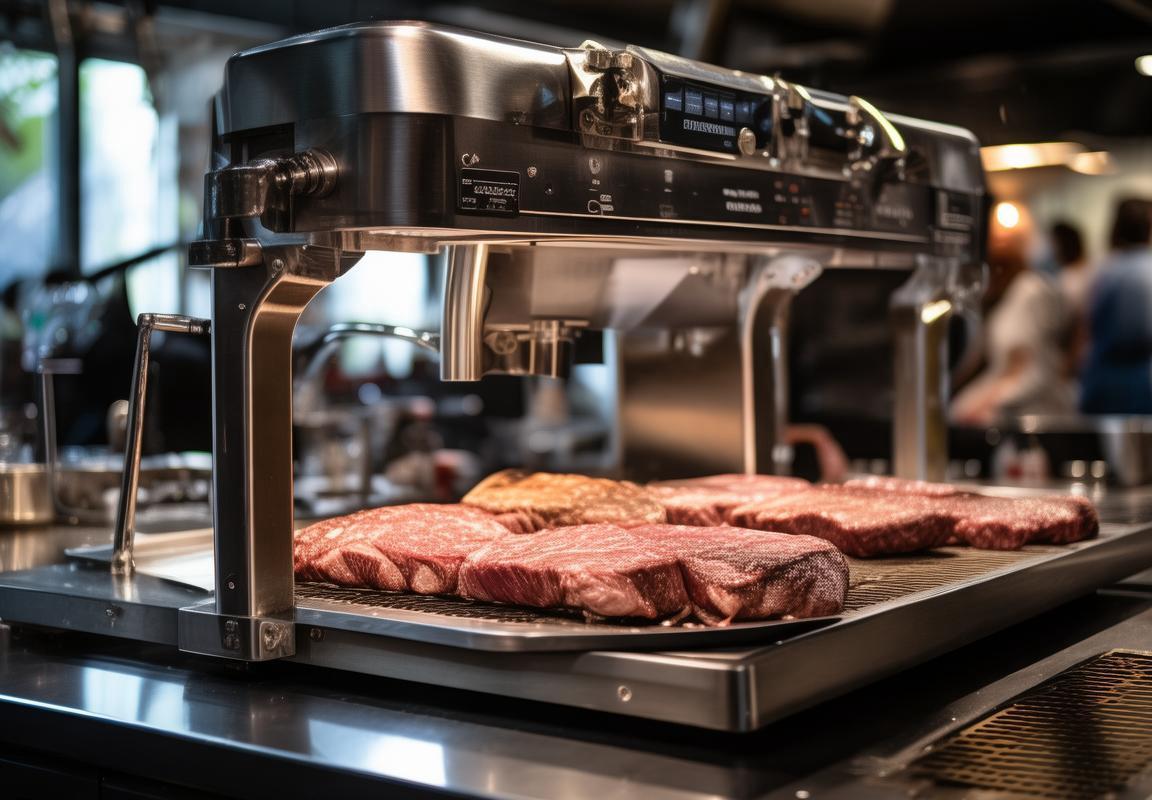
The Role of OEM Partnerships in Steak Machine Manufacturing
In the ever-evolving landscape of kitchen appliances, the role of Original Equipment Manufacturers (OEMs) has become pivotal, particularly in the context of specialized equipment like steak machines. These partnerships are not just about producing products; they are about driving innovation, ensuring quality, and meeting the unique demands of the restaurant industry.
OEM partnerships often begin with a deep understanding of the end-user needs. Restaurant operators are looking for solutions that can streamline their cooking processes, reduce labor costs, and enhance the quality of the food they serve. By collaborating with OEMs, they gain access to cutting-edge technology and expertise that can tailor steak machines to their specific requirements.
Customization is a key aspect of these partnerships. Each restaurant may have its own unique menu that requires a particular type of steak preparation. OEMs work closely with restaurant owners to develop machines that can handle different cuts, temperatures, and cooking times. This level of customization ensures that the steak machines not only meet but also exceed the expectations of the restaurant’s clientele.
Quality control is another critical function of OEM partnerships. The reliability and longevity of a steak machine are crucial for maintaining a high standard of food service. OEMs invest in rigorous testing and quality assurance processes to ensure that the machines they produce are robust, durable, and consistent in performance. This focus on quality not only satisfies the immediate needs of the restaurant but also fosters long-term trust between the OEM and the restaurant owner.
The integration of new technologies is also a significant part of OEM partnerships. Smart features, such as IoT connectivity, allow steak machines to be remotely monitored and controlled. This level of technology integration can lead to increased efficiency and the ability to adapt to changing customer preferences in real-time. For instance, if a restaurant decides to introduce a new type of steak dish, the machine can be easily updated to accommodate the change.
Collaboration in design and development is another aspect that sets OEM partnerships apart. Designers and engineers work hand-in-hand with chefs and restaurant owners to create machines that are not only functional but also aesthetically pleasing. The visual appeal of kitchen equipment can influence the overall dining experience, and OEMs recognize this importance.
OEM partnerships also play a role in cost-effectiveness. By producing in bulk, OEMs can achieve economies of scale that can be passed on to the restaurant owners. This can lead to significant cost savings over time, especially when considering the high volume of steaks a restaurant might cook daily. Additionally, OEMs often provide service and maintenance contracts, ensuring that the restaurant can operate without downtime and with minimal interruption to their service.
Moreover, sustainability is a growing concern in the food service industry. OEMs are increasingly integrating eco-friendly features into their steak machines, such as energy-efficient designs and recyclable materials. These environmentally conscious choices resonate with both restaurant owners who are looking to reduce their carbon footprint and with consumers who are becoming more aware of sustainable practices.
Finally, the support and training provided by OEMs are integral to the success of the steak machine in a restaurant setting. Operators need to feel confident in using the equipment, and OEMs offer comprehensive training programs to ensure that staff are proficient in operating the machines safely and effectively. This ongoing support helps to maintain the restaurant’s reputation for excellence in food preparation.
In summary, OEM partnerships in steak machine manufacturing are multifaceted, encompassing customization, quality control, technological integration, design collaboration, cost-effectiveness, sustainability, and support. These collaborations are not just about producing a piece of equipment; they are about creating a symbiotic relationship that enhances the overall quality of the dining experience and the efficiency of the restaurant’s operations.

Market Analysis: Trends and Growth Projections
The steak machine market, a niche within the broader kitchen appliances sector, has seen a surge in demand, driven by the fast-paced culinary landscape of restaurants worldwide. This growth is not only influenced by consumer preferences but also by technological advancements and strategic partnerships. Let’s delve into the market analysis, focusing on current trends and future growth projections.
The integration of smart technology has become a hallmark of modern restaurants, and steak machines are at the forefront of this transformation. These machines offer precision and consistency that are hard to achieve with traditional cooking methods, making them a sought-after addition to commercial kitchens.
As the demand for high-quality, fast-service restaurants increases, the need for efficient steak cooking solutions has grown exponentially. Customers are looking for quicker dining experiences without compromising on the taste and quality of their meals. Steak machines have stepped in to bridge this gap, offering a balance between speed and culinary excellence.
One of the key trends in the steak machine market is the shift towards customizability. Restaurants are no longer satisfied with one-size-fits-all solutions; they seek equipment that can cater to their unique menu items and cooking styles. This has led to a rise in OEM (Original Equipment Manufacturer) partnerships, where custom steak machines are developed to meet specific restaurant requirements.
OEM collaborations have allowed manufacturers to tap into the expertise of kitchen design professionals, ensuring that the steak machines not only perform well but also integrate seamlessly with existing kitchen infrastructure. This has resulted in a range of machines that cater to different cooking temperatures, steak types, and service volumes.
The global steak machine market is also witnessing a surge in demand from regions with growing middle-class populations. Countries like China, India, and Brazil are seeing a rise in the number of restaurants looking to adopt modern cooking technologies to enhance their offerings. This demographic shift has opened new markets and opportunities for growth.
In terms of growth projections, the steak machine market is expected to see a compounded annual growth rate (CAGR) of around 5-7% over the next decade. This projection is based on several factors, including the increasing number of restaurants, the expansion of the food service industry, and the rising popularity of steaks as a dish.
Another important trend is the emphasis on sustainability and energy efficiency. As environmental concerns grow, manufacturers are focusing on creating steak machines that consume less energy and have a lower carbon footprint. This not only aligns with the values of eco-conscious consumers but also helps restaurants reduce their operational costs.
The integration of data analytics and remote monitoring capabilities is also gaining traction in the steak machine market. These features allow restaurant owners to track the performance of their equipment, optimize cooking times, and reduce waste. The ability to monitor and manage steak machines remotely adds a layer of convenience and efficiency that is highly valued in today’s fast-paced business environment.
The competitive landscape of the steak machine market is diverse, with several established players and new entrants vying for market share. Major manufacturers are investing in research and development to innovate and improve their product offerings. They are also expanding their global reach through strategic partnerships and acquisitions.
As the market continues to evolve, it’s clear that steak machines will play a pivotal role in shaping the future of commercial kitchens. The industry’s focus on customization, sustainability, and technological integration will drive further growth and innovation. The steak machine market, once a niche sector, is now poised to become a key player in the culinary technology revolution.
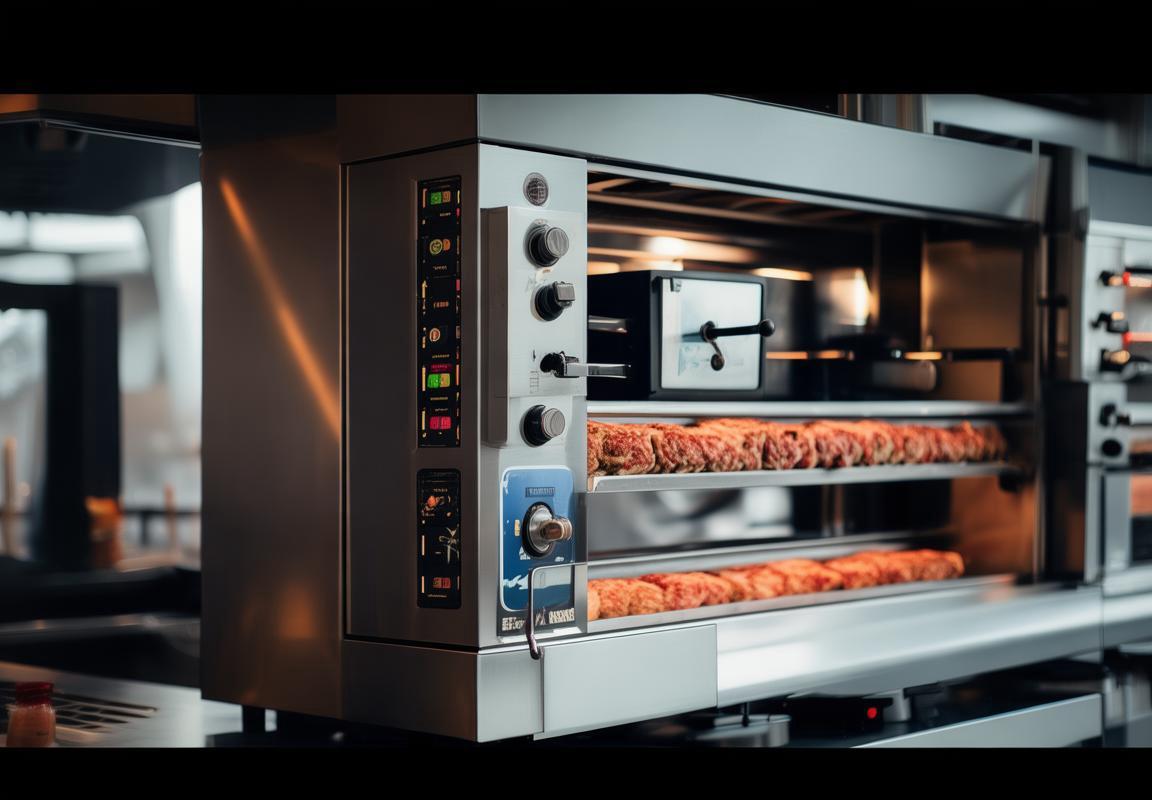
Key Players and Competitive Landscape
In the competitive landscape of the European and American kitchen appliance market, several key players have emerged as leaders in steak machine manufacturing. These companies not only drive innovation but also shape the industry’s direction. Let’s delve into the profiles of some of these influential players and the dynamics of the competitive environment.
Innovative German EngineeringGerman manufacturers are renowned for their precision and quality, and this is no different in the steak machine market. Brands like Miele and Thermador have established a strong presence, offering high-end, commercial-grade steak machines that cater to gourmet restaurants and fine dining establishments. Their products are often characterized by advanced technology and robust design, ensuring durability and efficiency.
American ingenuity in Steak Cooking TechnologyAmerican companies like KitchenAid and Breville have made significant strides in the steak machine sector, focusing on user-friendly designs and smart features. Their products often bridge the gap between home and commercial use, appealing to both casual home chefs and professional chefs looking for a high-quality appliance for their restaurants. The competitive edge for these brands lies in their ability to innovate while maintaining a balance between performance and affordability.
Japanese Precision in Steak MachinesJapanese manufacturers, known for their attention to detail and precision engineering, have also made their mark in the steak machine market. Brands such as Tiger and Zojirushi offer a range of steak machines that emphasize speed and ease of use. These machines are often compact and portable, making them a popular choice for food trucks, pop-up restaurants, and mobile catering services.
The Asian Market’s InfluenceAsian companies, particularly from South Korea and China, have been gaining ground in the steak machine industry. Brands like Samson and Supor are known for their competitive pricing and reliable products. These companies often leverage economies of scale and a robust supply chain to offer cost-effective solutions to both domestic and international markets.
European Diversity in Steak Machine OfferingsEuropean manufacturers bring a diverse range of steak machines to the market, reflecting the continent’s culinary traditions. Italian brands like DeLonghi and Gaggenau are known for their stylish designs and premium appliances. Meanwhile, French companies like Magimix and Moulinex offer a mix of commercial and domestic models, appealing to a wide customer base.
The Impact of GlobalizationGlobalization has played a pivotal role in the competitive landscape of steak machine manufacturing. As borders blur and markets become more interconnected, companies are finding new opportunities to expand their reach. This has led to a more diverse and dynamic market, where local brands can compete on a global stage.
Collaboration and PartnershipsTo maintain a competitive edge, many key players are forming strategic partnerships and collaborations. These alliances can range from joint research and development efforts to exclusive distribution agreements. By pooling resources and expertise, companies are able to push the boundaries of steak machine technology and offer more sophisticated solutions to customers.
The Rise of Smart AppliancesWith the advent of the Internet of Things (IoT), smart steak machines are becoming increasingly popular. Companies that can integrate connectivity and advanced features into their products are likely to gain a competitive advantage. This shift towards smart appliances is driven by consumer demand for convenience, control, and data-driven insights.
Environmental and Sustainability ConsiderationsAs environmental concerns grow, manufacturers are under pressure to produce eco-friendly steak machines. This includes using sustainable materials, reducing energy consumption, and designing products that are easy to recycle. Companies that prioritize sustainability are not only meeting regulatory requirements but also appealing to a socially conscious consumer base.
In conclusion, the competitive landscape of steak machine manufacturing is shaped by a variety of factors, including technological innovation, market trends, and strategic partnerships. As the industry continues to evolve, it will be interesting to see how these key players navigate the challenges and opportunities that lie ahead.

Benefits of Steak Machines in the Restaurant Industry
In the ever-evolving restaurant industry, the adoption of steak machines has brought about a significant transformation. These innovative devices are not just a trend but a game-changer, offering a multitude of benefits that enhance efficiency, consistency, and customer satisfaction. Let’s delve into the advantages that steak machines bring to the table.
The precision and speed that steak machines offer are unparalleled. By automating the cooking process, these machines ensure that every steak is cooked to perfection, with consistent doneness across the board. This level of precision is particularly valuable in high-volume kitchens where maintaining a high standard of quality is crucial.
Consistency is key in the restaurant business, and steak machines deliver just that. The same temperature, time, and pressure are applied to each steak, eliminating the human error factor that can lead to inconsistencies in cooking. This means that customers can expect a consistent experience each time they order a steak, which is essential for building a loyal customer base.
Labor costs are a significant concern for restaurant owners, and steak machines can help mitigate these expenses. By reducing the need for skilled chefs to spend time on the grill, these machines free up staff to focus on other aspects of service, such as customer interaction and kitchen tasks that require a human touch. This shift in labor allocation can lead to more efficient operations and potentially lower labor costs over time.
The health and safety of both customers and staff are paramount in the foodservice industry. Steak machines provide a controlled cooking environment that minimizes the risk of cross-contamination, a common concern when handling raw meats. With precise temperature control, these machines help prevent the growth of harmful bacteria, ensuring that the steaks served are not only delicious but also safe to consume.
Steak machines can also enhance the overall dining experience. In a world where customers are increasingly looking for unique and high-quality food experiences, these machines can be a talking point. They can be a centerpiece of the kitchen, showcasing the restaurant’s commitment to modern technology and culinary excellence. This can be particularly appealing to tech-savvy diners and those who appreciate the fusion of tradition and innovation.
The scalability of steak machines is another significant benefit. Whether a restaurant is small, medium, or large, these machines can be tailored to fit the kitchen’s needs. They can handle high volumes during peak dining times and still maintain the quality of the steaks. This flexibility allows restaurants to invest in these machines without worrying about their ability to handle varying levels of demand.
For operators looking to differentiate their offerings, steak machines can be a strategic asset. They allow for the creation of unique steak variations that might not be possible with traditional cooking methods. This can include different levels of doneness, unique marinades, or even innovative presentations. These customizable options can help restaurants stand out in a crowded market.
In terms of maintenance, steak machines are designed to be user-friendly and durable. Regular cleaning and maintenance are essential to ensure the longevity of these devices, but the process is straightforward and less time-consuming than traditional grilling. This reduces downtime and keeps the kitchen running smoothly.
From a sustainability perspective, steak machines can be a positive addition to a restaurant’s operations. By reducing the amount of energy used compared to traditional grills, these machines can help lower the restaurant’s carbon footprint. This is particularly important for establishments that are looking to adopt more eco-friendly practices.
Finally, the return on investment (ROI) for steak machines can be quite impressive. While the initial cost may be higher than traditional grills, the efficiency gains, labor savings, and improved customer satisfaction can lead to a faster payback period. Over time, the cost of operating a kitchen with steak machines can be significantly lower than with traditional methods.
In conclusion, the benefits of steak machines in the restaurant industry are multifaceted. From precision and consistency to labor savings and enhanced customer experience, these machines are more than just a cooking tool—they are a strategic investment that can elevate a restaurant’s offerings and operations.
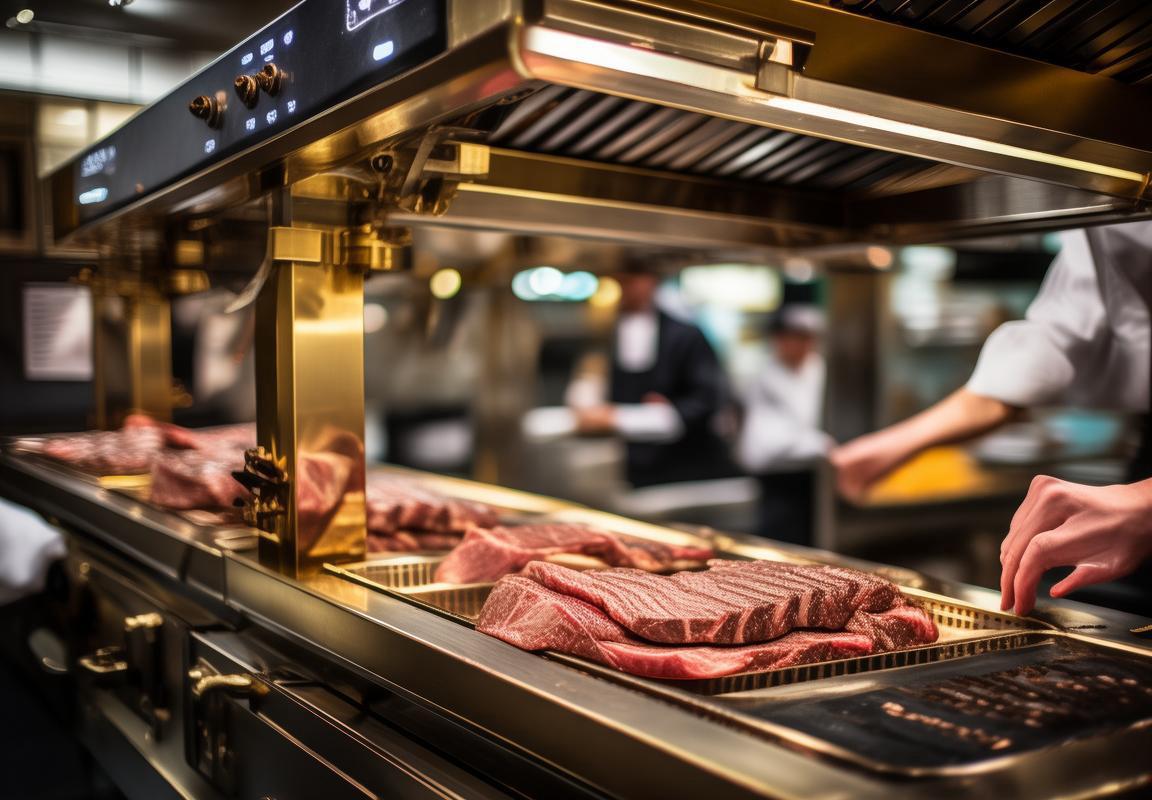
Innovation and Technological Advancements
In recent years, the kitchen appliance industry has witnessed a surge in innovation and technological advancements, particularly in the realm of steak machines. These developments have not only enhanced the efficiency and quality of food preparation but have also transformed the way restaurants operate. Here’s a closer look at some of the key innovations and technological strides made in steak machine manufacturing.
The integration of smart technology has been a game-changer. Steak machines now come equipped with digital controls that allow chefs to precisely adjust cooking temperatures, times, and even the degree of doneness. This level of customization was once a dream for many culinary professionals, but now it’s a reality, thanks to advancements in microprocessor technology.
One significant innovation is the use of induction heating in steak machines. Unlike traditional electric or gas grills, induction technology provides a more even heat distribution, resulting in a more consistent and delicious steak every time. This technology also offers faster cooking times and improved energy efficiency, making it a favorite among eco-conscious operators.
Another area where technology has made a substantial impact is in the design of steak machines. Modern appliances are not only sleek and compact but also designed with user-friendliness in mind. Touchscreen interfaces and intuitive controls make it easier for kitchen staff to operate the machines without extensive training, thus reducing the learning curve and increasing productivity.
The advent of wireless connectivity has also revolutionized steak machine operations. Many modern models are now compatible with kitchen management systems, allowing for real-time data tracking and remote monitoring. This feature is particularly valuable for restaurants with multiple units, as it enables centralized control and maintenance, reducing downtime and ensuring consistent quality across all locations.
In terms of material innovation, there has been a shift towards the use of high-quality, durable materials. Steak machines are now being constructed with stainless steel and other corrosion-resistant alloys, ensuring longevity and maintaining their appearance over time. The use of these materials also contributes to the overall hygiene of the kitchen, as they are easier to clean and maintain.
Safety features have also seen considerable improvement. Modern steak machines come with automatic shut-off mechanisms that activate if the machine is left unattended or if it detects an overheating situation. This not only protects the equipment from damage but also ensures the safety of kitchen staff and patrons.
One of the most notable technological advancements is the inclusion of AI and machine learning capabilities. These systems can analyze cooking patterns and preferences, learning over time to optimize the cooking process. This not only saves chefs time but also allows for the development of unique recipes and cooking styles that can differentiate a restaurant from its competitors.
The integration of IoT (Internet of Things) into steak machines means that they can be part of a larger network of kitchen appliances. This allows for seamless integration with other systems, such as inventory management and customer service platforms, creating a more cohesive and efficient operation.
Innovation in steak machine manufacturing is not just about the machines themselves; it’s also about the accessories and add-ons that complement them. For instance, the development of various steak-cutting tools and seasoning applicators has made it possible for chefs to prepare a wider variety of steak dishes with ease.
The advancements in technology have also led to a greater focus on sustainability. Steak machines are now designed with energy-saving features and are often more environmentally friendly than their predecessors. This is an important consideration for restaurants looking to reduce their carbon footprint and appeal to eco-conscious customers.
Lastly, the rise of modular design has allowed for greater flexibility in kitchen layouts. Steak machines can now be customized to fit various kitchen spaces, and they can be upgraded or replaced with minimal disruption to the kitchen’s workflow.
In conclusion, the innovation and technological advancements in steak machine manufacturing have brought about a new era in the restaurant industry. From smart technology and safety features to energy efficiency and sustainability, these advancements are shaping the future of kitchen appliances and the way we enjoy our steaks.
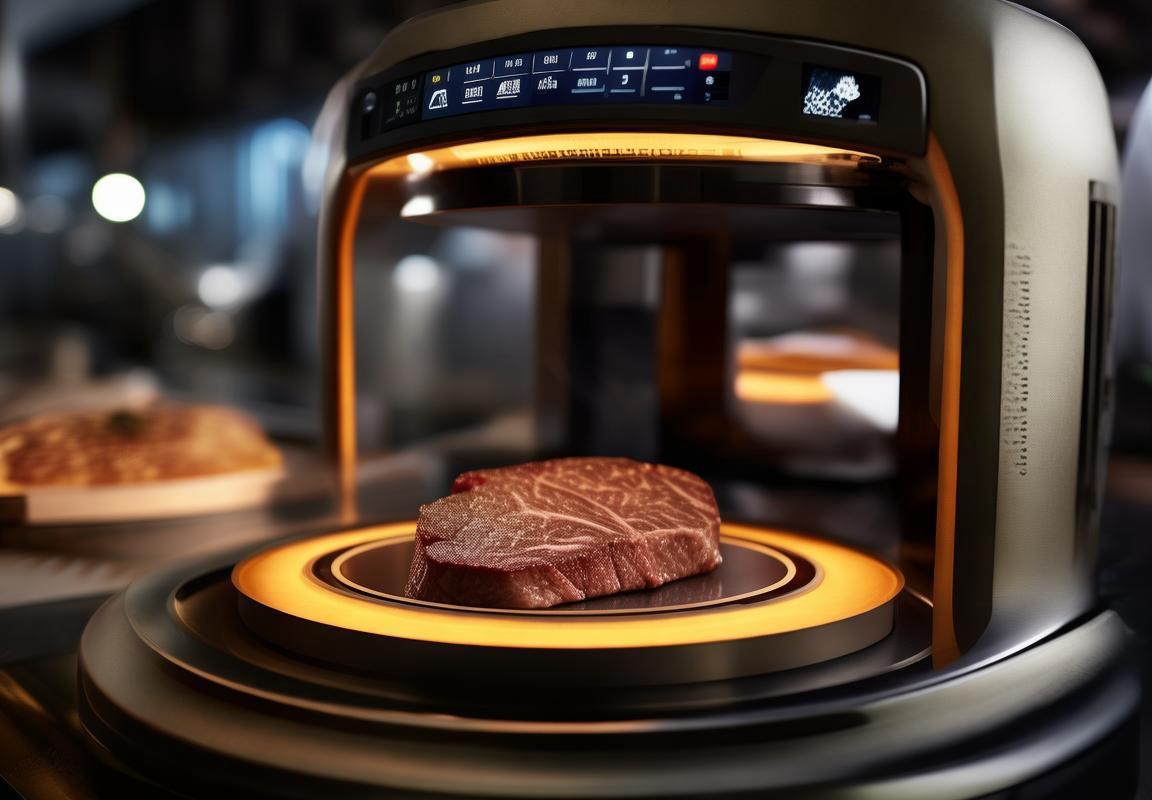
Challenges and Considerations for OEMs
Navigating the complexities of the OEM landscape requires a keen eye for challenges and careful consideration of various factors. As OEMs (Original Equipment Manufacturers) play a pivotal role in the production of steak machines and other kitchen appliances, understanding these hurdles is crucial for their long-term success and adaptability.
The demand for high-quality components and precision engineering is paramount in the OEM sector. Ensuring that each part meets stringent quality standards is a challenge, as the reputation of the final product hinges on the reliability of these components. OEMs must invest in rigorous testing protocols and maintain strict quality control measures to meet the expectations of their clients.
Supply chain management is another significant challenge. Fluctuations in raw material prices, transportation costs, and global trade policies can impact the bottom line. OEMs must find ways to mitigate these risks, whether through diversifying suppliers, entering into long-term contracts, or developing contingency plans.
Regulatory compliance poses a challenge for OEMs, especially in industries like kitchen appliances where safety and health standards are paramount. Adhering to local and international regulations requires a thorough understanding of the legal landscape and the ability to adapt quickly to any changes. This includes certifications, labeling requirements, and the development of sustainable practices.
The competitive nature of the market demands constant innovation. OEMs need to invest in research and development to stay ahead of the curve. However, this innovation must be balanced with cost considerations, as clients are often looking for cost-effective solutions. Balancing these two aspects is a delicate task that requires strategic planning and financial acumen.
Customization is a double-edged sword. While clients appreciate the ability to tailor products to their specific needs, it can complicate the manufacturing process. OEMs must have flexible production lines and a workforce capable of handling diverse orders without compromising quality or efficiency.
The integration of new technologies is a challenge that requires both capital and expertise. From incorporating IoT (Internet of Things) for remote monitoring to using AI for predictive maintenance, OEMs must be willing to invest in the latest technologies to improve their offerings. However, this also means training staff and potentially rethinking business models.
Sustainability is an increasingly important consideration for consumers and businesses alike. OEMs must balance environmental concerns with the production of efficient and long-lasting steak machines. This involves sourcing sustainable materials, reducing waste, and ensuring that the lifecycle of the product is as eco-friendly as possible.
Intellectual property protection is critical for OEMs. Protecting designs, patents, and trade secrets is essential to maintain a competitive edge. However, navigating the complexities of intellectual property laws across different regions can be daunting, and OEMs must be prepared to invest in legal expertise.
Lastly, the ability to scale operations is a challenge that must be addressed. As demand fluctuates, OEMs need to be able to scale up or down without incurring excessive costs. This requires efficient resource allocation, strategic planning, and a keen understanding of market trends.
In conclusion, the role of OEMs in the steak machine manufacturing industry is multifaceted, with challenges that require careful consideration and strategic solutions. By addressing these hurdles effectively, OEMs can not only meet the demands of the market but also position themselves for future growth and success.

Consumer Insights and Market Feedback
Understanding consumer insights and market feedback is crucial for Original Equipment Manufacturers (OEMs) in the kitchen appliances industry, especially when it comes to steak machines. Here’s an in-depth look at what these insights reveal:
The Importance of User ExperienceCustomers often prioritize the user experience when evaluating steak machines. They look for intuitive interfaces, ease of operation, and the ability to produce high-quality steaks consistently. Feedback from users indicates that simplicity in design and operation is highly valued, as it reduces training time for staff and enhances overall efficiency.
Customization and Personalization TrendsMarket feedback suggests a growing demand for customization and personalization in steak machines. Consumers are not just seeking machines that can cook steaks but ones that can also cater to specific preferences and dietary requirements. This includes adjustable heat settings, steak thickness controls, and even options for cooking with different marinades or spices. OEMs that can integrate these features are likely to see a positive response from the market.
Sustainability and Energy EfficiencyEnvironmental concerns are increasingly influencing consumer choices. Market feedback highlights a trend towards sustainable and energy-efficient steak machines. Customers are interested in products that minimize waste, use less energy, and have a lower carbon footprint. OEMs that focus on eco-friendly design and manufacturing processes are likely to attract environmentally conscious consumers.
Durability and MaintenanceLongevity and ease of maintenance are key factors in the consumer’s decision-making process. Steak machines that are built to last and require minimal upkeep are highly sought after. Market feedback often points to the importance of durable materials and robust construction. Users also appreciate clear maintenance guides and reliable customer support from OEMs.
Technology IntegrationThe integration of technology is another area where consumer insights are clear. Customers are interested in steak machines that can connect to kitchen management systems or even be controlled remotely via mobile apps. Features like real-time cooking data, predictive maintenance, and automated cleaning cycles are seen as valuable additions to modern steak machines.
Value for MoneyAffordability remains a significant factor in consumer decision-making. Market feedback indicates that while customers are willing to invest in high-quality steak machines, they expect good value for their money. This includes not only the initial cost but also the long-term costs of ownership, such as energy consumption, maintenance, and parts replacement.
Safety and ComplianceSafety is paramount in kitchen appliances, and steak machines are no exception. Consumers look for machines that meet stringent safety standards and are easy to clean to prevent cross-contamination. Market feedback often emphasizes the importance of compliance with food safety regulations and the use of materials that are safe for both the appliance and the consumer.
Feedback from Industry ProfessionalsFeedback from chefs and kitchen staff is invaluable for OEMs. Industry professionals seek steak machines that are reliable, consistent, and can handle the demands of a busy kitchen environment. They look for features like quick heat-up times, precise temperature control, and the ability to handle large volumes of steaks efficiently.
In conclusion, consumer insights and market feedback reveal a complex interplay of factors that influence the success of steak machines in the restaurant industry. From user experience and customization to sustainability and safety, OEMs must carefully consider these insights to develop products that meet the evolving needs and expectations of their customers.
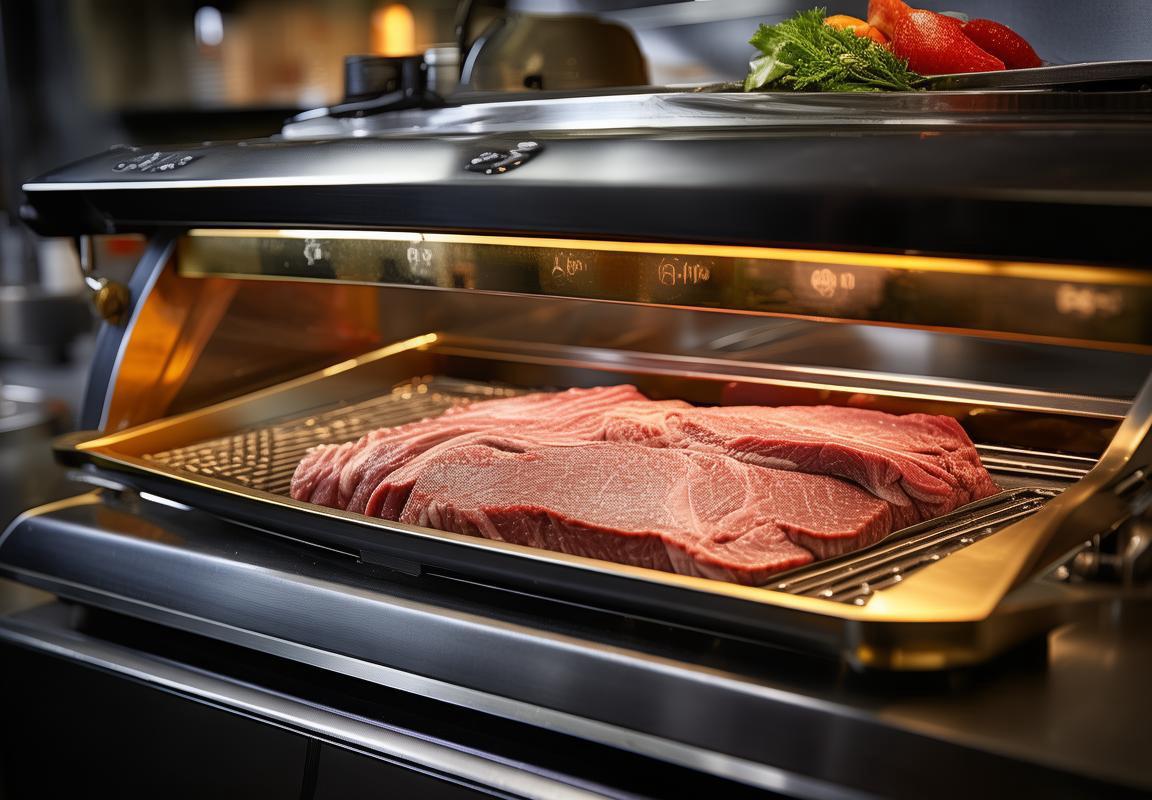
Conclusion: The Future of Steak Machines and the Kitchen Appliance Market
The future of steak machines and the kitchen appliance market is an intricate tapestry woven with innovation, consumer needs, and the ever-evolving landscape of culinary technology. As we look ahead, several factors are shaping the path that these machines will take, ensuring that they remain integral to modern kitchen operations.
The integration of smart technology is poised to become a cornerstone in the evolution of steak machines. With the rise of the Internet of Things (IoT), these machines are not just tools for cooking; they are data-driven devices that can optimize performance and efficiency. The ability to connect these machines to kitchen management systems allows for real-time monitoring and predictive maintenance, reducing downtime and enhancing overall kitchen productivity.
Customization is another trend that is gaining traction. As consumers become more discerning about their dining experiences, there is a growing demand for personalized options. Steak machines that can accommodate various cuts, cooking temperatures, and doneness levels are becoming more popular. This not only caters to the preferences of different customers but also opens up new opportunities for restaurants to offer unique menu items.
The sustainability angle cannot be overlooked. With environmental concerns at the forefront of global consciousness, manufacturers of steak machines are under pressure to create products that are energy-efficient and eco-friendly. This includes the use of sustainable materials and the design of machines that consume less power, contributing to a greener kitchen environment.
The competitive landscape is becoming increasingly diverse, with a range of players vying for market share. Established appliance brands are branching into the culinary technology sector, while startups are bringing fresh ideas and disruptive technologies to the table. This competition drives innovation and keeps the market dynamic, with new features and functionalities being introduced regularly.
Regulatory compliance is a critical consideration for OEMs (Original Equipment Manufacturers) in the steak machine market. As health and safety standards evolve, manufacturers must ensure that their products meet the latest regulations. This often requires ongoing investment in research and development to keep pace with changing legal requirements.
The global nature of the market also presents challenges. Distributing products across different regions means adapting to varying local tastes and cooking preferences. OEMs must navigate cultural differences and sometimes invest in local production facilities to ensure that their products are well-received and supported.
In terms of consumer feedback, the market is witnessing a shift towards more interactive experiences. Customers are not just looking for a quality meal but also an engaging experience. Steak machines that can provide entertainment or educational content about the food being prepared are likely to resonate well with consumers, especially in high-end dining establishments.
The rise of foodservice apps and online ordering platforms has also influenced the steak machine market. These digital services have changed the way consumers interact with restaurants, and OEMs are responding by developing machines that can integrate seamlessly with these platforms. This could include features like mobile order acceptance and automated preparation systems.
The future of steak machines is not without its challenges. The cost of innovation can be high, and the return on investment may not always be immediate. Additionally, the rapid pace of technological advancement means that products can quickly become outdated. OEMs must balance the need for continuous improvement with the financial realities of the market.
Finally, the integration of steak machines into the broader kitchen appliance market is a significant consideration. As these machines become more sophisticated, they may start to compete with other kitchen appliances, such as ovens and grills. This could lead to a convergence of product features and functionalities, creating new opportunities for cross-selling and market expansion.
In conclusion, the future of steak machines and the kitchen appliance market is a multifaceted one. It is driven by consumer demands, technological advancements, and the competitive landscape. OEMs that can navigate these challenges, innovate effectively, and adapt to changing market dynamics will be well-positioned to shape the future of this exciting industry.